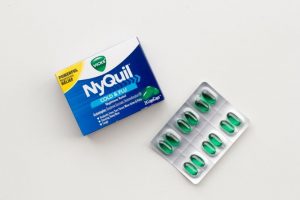Can you take Tylenol with Mucinex? Tylenol works great for headaches. Mucinex works great for congestion. But, what if you have both a headache and congestion? Can you take Mucinex with Tylenol at the same time?
Can you take Tylenol and Mucinex together? Yes, you can take Tylenol with Mucinex. No negative interactions have been found when mixing the two medicines. Just ensure that you don’t take more than the maximum daily dose for each.
Tylenol has acetaminophen as an active ingredient. Mucinex has guaifenesin or dextromethorphan as an active ingredient.
However, both Tylenol and Mucinex have combination products. Meaning, there may be Tylenol products that contain guaifenesin and dextromethorphan, or there may be Mucinex products that contain acetaminophen. To be sure, check and read the label to avoid an overdose.
Read on to learn more about taking Tylenol and Mucinex, how much you should take, and when you should take them.
Can You Take Tylenol with Mucinex?
Tylenol and Mucinex are well-trusted brands that are readily available over the counter. Are they okay to take together? What medications can you take with Tylenol? What drugs can you take with Mucinex?
Tylenol is a brand by McNeil Consumer Healthcare, a subsidiary of Johnson and Johnson. The active ingredient in Tylenol is acetaminophen.
Reckitt Benckiser manufactures Mucinex, which has guaifenesin as its active ingredient. The active ingredient for their original Mucinex product is guaifenesin. Meanwhile, some Mucinex products also contain dextromethorphan, which is also a remedy for cough.
- Acetaminophen is a fever reducer and pain killer. If you need one, you can purchase it over the counter. It is also often added to create combination drugs for multi-symptom relief.
- Guaifenesin is an expectorant. Therefore, you can use this medicine to ease congestion caused by the common cold. It acts by loosening phlegm in your chest and throat so that it is easier to cough up.
- Dextromethorphan is a cough suppressant. It taps the signals in the brain that trigger coughing. However, dextromethorphan will not relieve a cough that is associated with asthma, emphysema, or smoking.
Tylenol and Mucinex can be taken together without any unsafe drug interactions. Tylenol has products that are for multi-symptom cold and flu. Some of these products contain guaifenesin and dextromethorphan as active ingredients.
Mucinex also has products for the relief of multi-symptom cold. Some of these products contain acetaminophen as well. To clarify, if the Tylenol or Mucinex you’re taking contains active ingredients like acetaminophen, guaifenesin, and dextromethorphan, then there’s no need to take another dose of these medicines.
Always read the label too. It is essential to read the active ingredients of the medications you are taking.

What Is Tylenol?
Tylenol is a well-known brand name for the drug acetaminophen. You can use it to reduce fever, aches, pains, headaches, muscle aches, arthritis, toothache, backache, and many others.
The Recommended Dose of Tylenol
- For People Weighing over 109 Pounds – you must not take more than 1,000 mg at one given time. Also, you must not exceed more than 4,000 mg in 24 hours. People can take them in scheduled doses every 4 or 6 hours instead.
- Children 12 Years and Below – A dosage chart printed on the box helps children 12 years and below get their right dosage. The correct dosage will depend on the formulation and grams of the Tylenol for children you are buying. It is usually computed according to a child’s weight and age. Use as directed on the label.
Avoid using medications that also contain acetaminophen when you are taking Tylenol. It could lead to an overdose, which could sometimes be fatal.
If you have an allergy history to acetaminophen, avoid using products with Tylenol. Signs of allergy to acetaminophen may be skin redness or rash.
What Is Mucinex?
Mucinex is a brand for the drug guaifenesin. Some of their products also contain dextromethorphan, a drug used for treating cough. In addition, they have other products, which contain different ingredients that are for multi-symptom cough and colds.
For temporary relief of chest and throat congestion due to the common cold, bronchitis, or other breathing ailments, you can use Mucinex. Mucinex is also available as an over-the-counter remedy.
Guaifenesin is an expectorant that works by thinning out and loosening mucus in the airways so that you can quickly expel it. Moreover, dextromethorphan is a cough suppressant. It acts on the brain signals that make you cough involuntarily.
The Recommended Dose of Mucinex
- For Adults and Teens (12 Years Old and Above) – Take the immediate-release formulation (200 or 400 mg) every 4 to 6 hours orally. Do not take more than 2,400 mg per day.
- For Children Younger Than 2 Years Old – Give 12 mg per kilogram of body weight in 6 divided doses, orally.
- For 3 to 5 Years Old – 50 to 100 mg orally every 4 to 6 hours. Do not exceed 600 mg per day.
- For 6 to 11 Years Old – Give 100 mg to 200 mg orally every 4 to 6 hours. Do not exceed 1,200 grams per day.
Mucinex also has a sustained release formulation. So, it’s best to read the label for its dosage as it is different from the immediate release variant.
The Available Preparations for Tylenol
Tylenol has developed many more products after it came out with the original Tylenol caplets. These products are:
- Tylenol Regular Strength – Tablets that come in 375 mg preparations.
- Regular Strength Liquid Gels (Tylenol) – Gelcaps in 375 mg preparations.
- Extra Strength (Tylenol) – Caplets that come in 500 mg preparations.
- Tylenol Extra Strength Dissolve Packs for Adults – Flavored formulation and in powder form. No need to add water. This product also comes in 500 mg preparations.
- Tylenol Extra Strength Coated Tablets – Easy to swallow small tablets that come in 500 mg preparations.
- Tylenol Rapid Release Gel – These are gel caps with laser-drilled holes for faster release. They come in 500 mg preparations too.
Tylenol for Children
For children, Tylenol has the following varieties:
- Tylenol Children’s Chewables for 2 to 11 Years Old – Comes in 160 mg preparations.
- Tylenol Children’s Dissolve Packs – The same as the Adult Dissolve Packs for 6- to 11-year old children. They also come in 160 mg preparations.
- Tylenol Children’s Liquid for 2 to 11 Years Old – Comes in 160 mg preparations.
- Tylenol Infants’ Liquid – In suspension form that comes in 160 mg preparations.
Multi-Symptom Tylenol Formulations
Multi-Symptom formulations for Tylenol are for the relief of multi-symptoms of colds and flu. They include:
- Tylenol Sinus and Headache
- Cold Max Daytime
- Cold Flu and Cough Nighttime
- Tylenol PM
- Arthritis
- Tylenol Cold and Flu Severe for Day and Night
If you are taking any of the Multi-Symptom preparations of Tylenol, always read the label. In addition, avoid taking anything that has guaifenesin if you want to take Mucinex, as it is Mucinex’s active ingredient.
The Available Preparations for Mucinex
- Mucinex Extra Strength 12 Hour Extended Release – These are time-release bi-layer tablets. So, you need to take one pill for 12 hours. It comes in 1,200 mg guaifenesin extended-release preparation.
- Mucinex DM 12 Hour Extended Release – These are also time-release tablets. It is an expectorant and cough suppressant. This medicine contains 600 mg guaifenesin and 30 mg dextromethorphan preparations.
Mucinex has Multi-Symptom formulations for the relief of multi-symptom cough, colds, and flu. Among them are:
- Mucinex Fast-Max Severe Congestion and Cough Liquid
- Sinus-Max
- Mucinex Maximum Strength Sinus Pressure Relief
- Mucinex Maximum Strength Fast-Max severe Cold
When you are taking any of the Multi-Symptom preparations of Mucinex, check the label. If they already contain acetaminophen, it is best not to take any more medicine with acetaminophen, including Tylenol.

We have already answered the question, “Can you take Tylenol with Mucinex DM or regular Mucinex?” or “Can you take Mucinex and Tylenol together”; Now, let’s look at how to how to take Tylenol and how to take Mucinex.
How to Take Tylenol
- It would help if you took Tylenol precisely as prescribed by your doctor or according to the package label. Moreover, it would be ideal not to take amounts that are larger or smaller than the recommended dose.
- If you take more than the recommended and prescribed dose, you risk getting an overdose as well as liver damage.
- For children, always use the pediatric form of Tylenol. Use the dropper, syringe, or measuring cup that comes with the product. If you have the suspension form, make sure to shake the bottle well before intake.
- Tylenol is safe to take even on an empty stomach. You should, however, always take a full glass of water with it.
- Store Tylenol at room temperature.
If you have these symptoms after taking Tylenol, it is best to consult a doctor:
- You have a sore, painful throat even after two days
- A fever for three days
- You have muscle aches that don’t seem to get better after seven days of taking Tylenol
- A skin rash appears
- You have a headache even after two days
- Nausea and vomiting
- You develop new symptoms
How to Take Mucinex
- It would be best if you took Mucinex precisely as prescribed by your doctor or according to the package label. All cough medications are usually taken for a short period until symptoms ease up. Also, avoid taking Mucinex in larger or smaller doses.
- It is best to take Mucinex with food as it may upset your stomach. Take it with a glass of water too.
- If you’re taking the liquid form of Mucinex, always use the measuring cup that comes with it. For children taking Mucinex, use the dropper or oral syringe, which also comes with the product.
- As with any cough medications, it is best to take a lot of liquids with the drugs to further help in loosening the phlegm.
- Store it at room temperature.
Moreover, consult a doctor if you’re taking Mucinex and experience the following symptoms:
- You experience wheezing with your cough
- You are having shortness of breath
- A rash accompanies your cough
- You experience fainting
- Your cough doesn’t get better after a week
Additionally, it is best to seek emergency treatment when you have the following symptoms with your cough:
- You are coughing up blood or blood-streaked phlegm
- Having chest pains
- Have breathing difficulties
- Nausea and vomiting
What Happens and What Should I Do If I Miss a Dose of Tylenol and Mucinex?
You can take Tylenol and Mucinex as needed unless your doctor prescribes it round the clock for a certain number of days. If you forgot a dose, take the medicine as soon as possible. Then, adjust your schedule accordingly.
And if you forgot to take it and it is almost time to drink your next dose, skip the needed dose and take it on your following schedule.
What Should I Avoid When Taking Tylenol and Mucinex?
Mention to your doctor if you’re taking other medications that contain acetaminophen, guaifenesin, or dextromethorphan. Many other medicines for cough, cold, and flu contain these active ingredients. Thus, you might be taking too much of the active ingredients and risk getting an overdose.
Moreover, avoid taking any form of alcohol when you’re taking either Tylenol or Mucinex. It may increase your chances of liver damage. Mucinex may also impair your thinking and reactions temporarily. So, avoid physical activities that require you to be alert while taking Mucinex.
Conclusion – Can You Take Mucinex with Tylenol?
So to recap, can you take Tylenol with Mucinex DM or regular Mucinex? Yes, it is safe to take Tylenol and Mucinex together. No negative interactions exist when mixing the two medicines. Just ensure that you don’t take more than the maximum daily dose for each.
Both Tylenol and Mucinex have combination preparations that contain the active ingredients of both brands.
If you are taking a combination formulation from either Tylenol or Mucinex, make sure that you aren’t doubling up the doses of their active ingredients. So, always check their product labels and follow dosing recommendations.
Read next:



